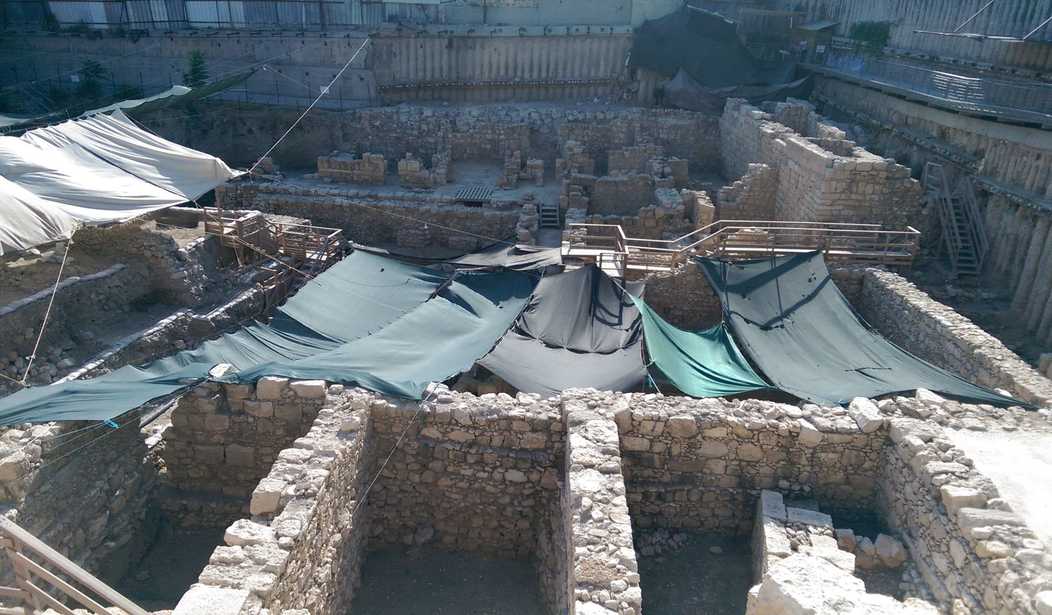Lest anyone doubt the basic historicity of the Bible, archaeological excavations near the Temple Mount continue to provide strong evidence. In turn, they bolster both faith and, for those with minds not yet too cynical, a sense of wonder.
The latest big discovery, announced last week, is a clay seal, or “bulla,” of King Hezekiah of Judah, a leader highly praised in the Old Testament who lived around 700 B.C. Not that Hezekiah’s existence and reign were in doubt: Plenty of other historical texts confirm his kingship and its basic contours (indeed, more so than most other Hebrew kings). Yet the details of this seal – its symbology, including hieroglyphs representing “life” – tend to support the Biblical account of his recovery from a life-threatening illness and his alliance with Assyrian rulers.
What may be of more interest to ordinary readers not versed in archaeological or Biblical minutia is the larger story of the overall excavations in that part of Jerusalem. On a delegation to Israel in late summer of 2014 (led by former U.S. Sen. Rick Santorum), as Palestinian rockets rained down on the Jewish homeland, we were treated to quite a visit of the various digs. The story is remarkable: As developers planned to build on a site near the Temple Mount, archaeologist Dr. Eilat Mazar swooped in: She insisted that the ancient City of David actually was there rather than inside the walls of what is now known as the Old City of Jerusalem.
Dr. Mazar was right: They found the actual ruins of David’s palace, right where she said they would be. Further excavations found artifacts supporting several other major stories from the Bible – including seals of princes who persecuted the prophet Jeremiah and even what is almost certainly the well into which they threw him. They also uncovered a secret tunnel possibly used by King David as he took control of the city.
Carbon dating and other tools of the trade have helped the researchers peg most of the artifacts to fairly specific time periods and identify their usages and significance.
All of which information might still make a rather dry, academic impression on a page (or cyberpage). In person, though, the effect is anything but academic. Instead, it is awe-inspiring. Not much of the palace remains — but the old stone blocks that do still exist are enough to give a sense of its grandeur, so that as you walk around the place, you can really feel the history of 3,000 years.
Suddenly you’re faced with the reality that these Biblical stories aren’t mere myths. These aren’t invented tales like Zeus posing as a swan or Aphrodite floating on a seashell.
Instead, although the Old Testament is writ in mythic proportions, its heart is real history. And as you feel the very walls of the palace, or peer down into the main excavation site, or traverse the long, semi-damp tunnel, you get a sense of how human striving and struggles themselves can have mythic–grand–significance.
Here’s what else the visitor realizes: Unlike other claimants to Jerusalem (with stories of magical nighttime journeys of hundreds of miles by air, for example), the Jewish people have a deep and abiding, real-life connection to the land and the city. Their whole history–their communal story–revolved around what is now Israel and especially the Jerusalem that for 3,000 years has been the central metropolis of their people and their faith.
And–getting back to Hezekiah, he of the newly discovered seal–it was the Jerusalem of a king 2,700 years ago who, the Bible says, did honor to the Lord and kept his people free from harsh subjugation by foreign rulers. As reported in 2 Kings: “He held fast to the Lord and did not stop following him; he kept the commands the Lord had given Moses. And the Lord was with him.”
The great prophet during Hezekiah’s time was Isaiah, also probably the prophet most revered and cited by Christians due to his numerous verses interpreted as foretelling the coming of Christ.
Said Isaiah to Hezekiah as Hezekiah lay near apparent death: “This is what the Lord, the God of your father David, says: I have heard your prayer and seen your tears; I will heal you. On the third day from now you will go up to the temple of the Lord.”
Hezekiah did not die then, but lived 15 more years. And with this newfound “bulla,” he in effect comes to life again, symbolized by a sun with sheltering wings, with a symbol of life at the end of each wing.
What lives, too, is the faith that Hezekiah practiced–and the separate religion, Christianity, that grew from the faith tradition of Hezekiah … and from the birth of a savior whose coming, Christians believe, was feted (and fated) by Hezekiah’s favorite prophet.
Quin Hillyer is a veteran conservative columnist. He has an undergraduate degree in Theology from Georgetown University and has served for years in various forms of ecumenical lay leadership.



![Ruins of King David's Palace Near the Temple Mount in Jerusalem [Image Courtesy of Quin Hillyer]](https://pjmedia.com/faith/user-content/52/files/2015/12/IMAG0178.jpg)






Join the conversation as a VIP Member